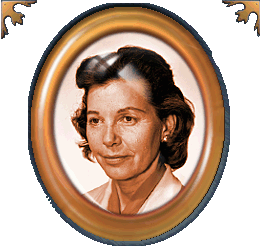Birk: Let me first go back. When we first arrived there was very little furniture in the house. The dining room was complete. It had tables and chairs for 42 guests. There was nothing in the living room except the carpet was in—it was a gold carpet. Upstairs I think there was some kind of sectionated group. But my job was to furnish the house, to chose the furniture for the house.
Erickson: Were the Spieth's actually the first family to live there?
Birk: That was true, was it not?
Hinderaker: That is correct. The Spieths were involved along with Clark Kerr and the people in the President's Office in the design and plan of the building. It was built privately however and sold to the university. Fred Jennings was the person who built the house privately. It was all designed by Evelyn Spieth and …
Birk: And Kay Kerr. Let me talk about the design of the house. I remember being outside and some child going by and saying,
"Do you live in that mortuary?" And then somebody else said, "Do you live in that motel?"
So the house was what you call very institutional, two rooms and a study in the back for us (two bedrooms and a study). And there was the upstairs room, and there was a dining room downstairs and the living room. The kitchen was very institutional. There was no place to sit. It was sort of row on row of cabinets, you know. Riveras later put the room on outside, you know, they built that on. We had a little bar to eat on when we were alone.
Hinderaker: (chuckling) Yes, I forget where we ate.
Birk: Anyway my first job was to decide on the furnishings of the house. Luckily, a couple of years before, I had taken a course in interior decorating. I was trying to remember her name, and I looked up some old calendars, and it was Mrs. Woodbridge from UCLA Extension. So I called her and said this is what I had to do.
I arranged to meet her in LA about five different times. Each time we would go into a different showroom. The first showroom we went into in a decorator area in LA (I've kind of forgotten some of those names), I found everything I wanted in the living room. It was one of those things where I walked in and said, "I'll take that, that and that." There were a couple of davenports, four chairs around a coffee table, another coffee table, a sofa-back table, a bench ...
Well first of all, in interior decorating you decide on the adjectives you want to express in whatever you have. The adjectives to work with this house would be to make it comfortable ... I had it written down here ...
Hinderaker: You wanted warm in there.
Birk: Warm, comfortable and interesting. So the colors would be the warm colors, and this would relate to the citrus. The rugs were gold to begin with. So those are the colors we would work with, and then we had what furniture I had picked out, and then I would chose the fabric and colors for that. Then (I said five times) another time I would just go into LA and look at lamps. Another time I went in to look at the wallpaper. And then I'd go back to Riverside. It took a whole year by the time we began with that process to get the things on campus.
And then the thought came to me to make it interesting, to make it a gallery of Riverside artists, mainly women who would loan to the House to display as a gallery.
Now this is one of the most important things that happened to that house. It made it come alive. The one thing that I did all year personally was to have a luncheon for the artists at the House at the beginning of the year and have one in June at the end of the year so they could take their art for the summer because I wasn't going to be there. And we weren't having any functions in the House in the summer.
But the artists of the House became ... and there were some thirty women who supplied the House. I was looking on my calendars to find out how many really came to those artist's luncheons, and I found there were twenty six, twenty two or whatever.
So there was a group that would come. And this is fascinating, these lunches, because these artists knew each other fairly well or knew their names. We'd go around the table and they'd talk about what they were doing, what special thing they were painting or working on. Some were sculpting. It became such a wonderful thing for the House and for each other and relationships.
And the art in the House became very important because so many guests in the House would be people that we probably didn't know or were meeting for the first time or they didn't know each other.
A principle of relationships is to talk about the near at hand. I want to talk to you and I don't know anything about you and you don't know anything about me. What do you talk about? Where do you start? The near at hand is what you talk about, so the art became the near at hand. I would give them a tour of the art in the House, and then it just flowed.
